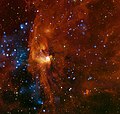File:Massive Young Stars Trigger Stellar Birth.jpg
Appearance

Size of this preview: 631 × 599 pixels. Other resolutions: 253 × 240 pixels | 505 × 480 pixels | 808 × 768 pixels | 1,078 × 1,024 pixels | 2,156 × 2,048 pixels | 3,300 × 3,135 pixels.
Original file (3,300 × 3,135 pixels, file size: 3.22 MB, MIME type: image/jpeg)
File history
Click on a date/time to view the file as it appeared at that time.
| Date/Time | Thumbnail | Dimensions | User | Comment | |
|---|---|---|---|---|---|
| current | 18:18, 21 June 2011 |  | 3,300 × 3,135 (3.22 MB) | Spitzersteph |
File usage
The following page uses this file:
Global file usage
The following other wikis use this file:
- Usage on fr.wikipedia.org
- Usage on fr.wikibooks.org


